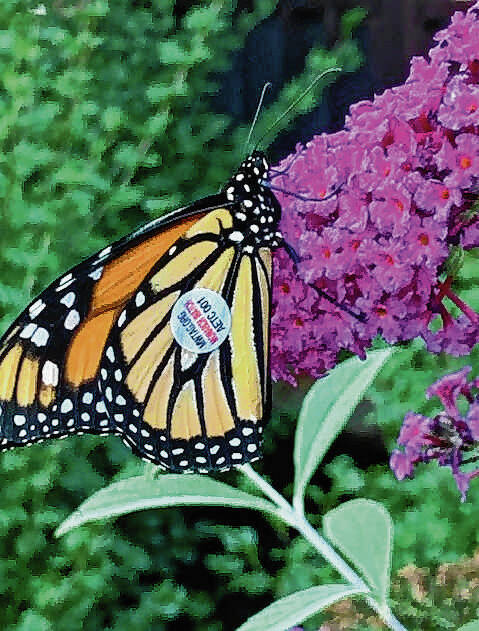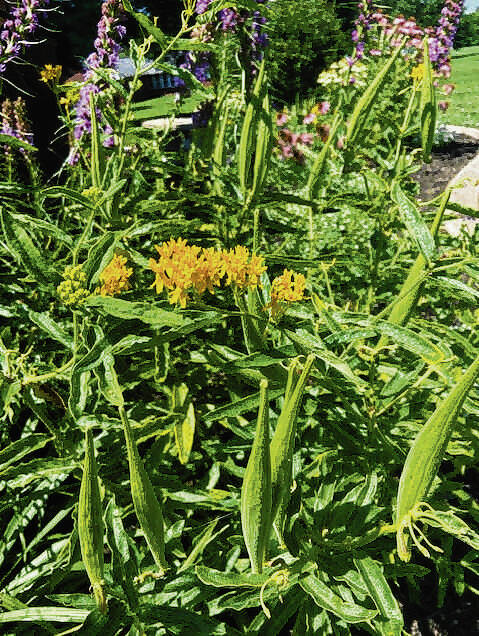Growing up in Wisconsin, Rosy Jennings remembers seeing an abundance of butterflies.
In particular, monarch butterflies because they migrated through that area on their way to Mexico.
They embark on a migratory phenomenon, traveling between 1,200 and 2,800 miles or more from the northeast United States and southeast Canada to the mountain forests in central Mexico, where they find the right climate conditions to hibernate from the beginning of November to mid-March, according to worldwildlife.org.
“Our trees were dripping with monarchs, just dripping,” Jennings said. “Oh my gosh! It was just beautiful. I’m just fascinated with butterflies, and especially the monarchs.”
Over the years, though, she began seeing fewer butterflies.
Now, the monarch butterfly is considered an endangered species by the International Union for the Conservation of Nature. The group estimates the population in North America has declined between 22% and 72% over 10 years.
Jennings and her husband, John, have lived in a subdivision south of Seymour for 27 years and have milkweed and other plants in their yard to attract butterflies.
On Sept. 28, 2021, they experienced a couple of firsts.
Rosy saw a butterfly she had never seen before and was looking in a book to try to identify it, and then she saw a monarch land on one of their butterfly bushes and noticed a sticker on it.
She went in the house and told John, who was just as puzzled as her.
“We went out there and it took me awhile to take the picture because the butterfly kept flying away, and I finally got the butterfly to sit,” she said. “I got this picture, and then I blew it up and then I went into the house and entered those numbers in the computer, and up popped this website for butterflies that are tagged every year to track their migration.”
The tag had “Mwtag.org, Monarch Watch, AETC 001” on it.
“If you go on that website, you will see how to become a tracker, how they actually put the tags on the butterflies, how they track the migration and things like that,” Rosy said. “They ask people like myself, if you come across this butterfly, that tracking number, tell us where you live, what time it was and what day it was when you saw it, so I put that information in there.”
Rosy learned the butterfly was tagged and released in Westfield.
The Monarch Watch Tagging Program is a large-scale community science project that was initiated in 1992 to help understand the dynamics of the monarch’s fall migration through mark and recapture, according to monarchwatch.org.
Tagging originally was used by Dr. Fred Urquhart of the University of Toronto to help locate overwintering monarchs and later to determine where monarchs came from that wintered in Mexico.
The long-range tagging program continues to reveal much more. Tagging helps answer questions about the origins of monarchs that reach Mexico, the timing and pace of the migration, mortality during the migration and changes in geographic distribution, the website states.
It also shows the probability of reaching Mexico is related to geographic location, size of the butterfly and the date, particularly as this relates to the migration window for a given location.
To be able to associate the geographic mark location with that of any subsequent recapture, each butterfly tagged must be uniquely coded. A new series of unique codes is generated for each tagging season and printed using permanent inks on all-weather tags with a pressure-sensitive adhesive backing.
The lightweight circular tags were designed by Monarch Watch specifically for tagging monarchs. When applied as directed, the tags do not interfere with flight or otherwise harm the butterflies.
Each fall, the program distributes more than a quarter of a million tags to thousands of volunteers across North America who tag monarchs as they migrate through their area. These “community scientists” capture monarchs throughout the migration season, record the tag code, tag date, gender of the butterfly and geographic location and then tag and release them.
At the end of the tagging season, the data are submitted to Monarch Watch and added to the database to be used in research.
Rosy said she recently talked to someone at Muscatatuck National Wildlife Refuge in Seymour who is from California, and she hadn’t seen a tagged butterfly before. Monarchs also make their way out to coastal California to congregate.
“Everybody I’ve talked to, anybody that likes anything birds, flowers, butterflies, whatever, no one else has ever seen a tagged butterfly, so everyone is really fascinated when I show them (the picture),” she said.
Since the monarch butterfly population continues to decline, the Jenningses maintain bushes and flowers for the pollinators.
“We actually started planting a milkweed pot that flowers, so it’s not just a green milkweed pot. It has got flowers on it, and those are the only plants that they actually come and lay their eggs on,” Rosy said. “We started that three years ago, and we have seven plants in our yard right now.”
The refuge has started planting them, too, she said.
“There will be articles in newspapers and magazines and they are encouraging people to plant these forms of milkweed plants so we can boost back up (the population of monarchs),” she said.
She credits the population decline to climate change and habitat.
“Used to … the roadsides weren’t cleared out. There was more vegetation, the milkweed,” she said. “You saw them as a kid. You saw them everywhere. (Now) you don’t see it very often.”
This year, Rosy said she has only seen one monarch butterfly at her home.
“Of course, every time now I see a monarch out there, I’m running out there to see if it’s tagged,” she said, smiling.
“Right now, we’re getting pods on milkweed, so we’re watching because once they start getting the pods on them is when we notice the butterflies start to eat on them and then start to lay their eggs,” she said. “I haven’t seen them laying any eggs yet, but they are transitioning from the flowers to the pods.”



